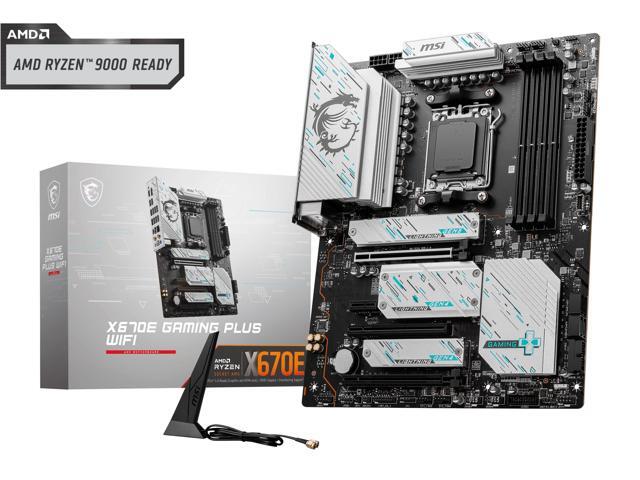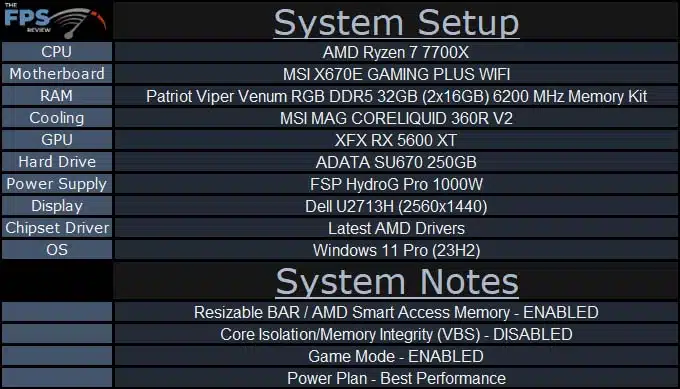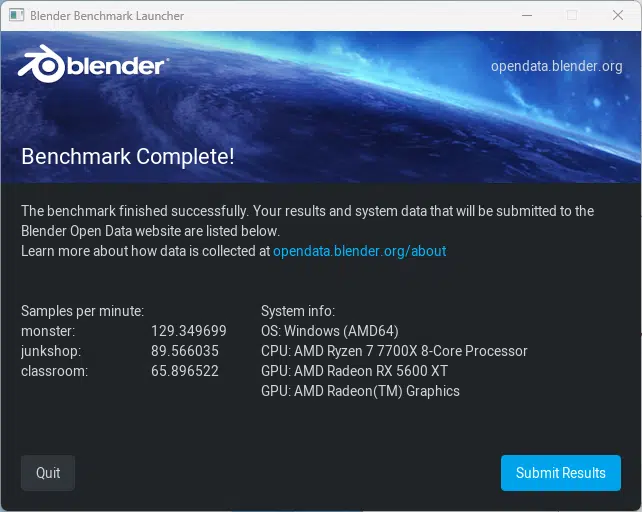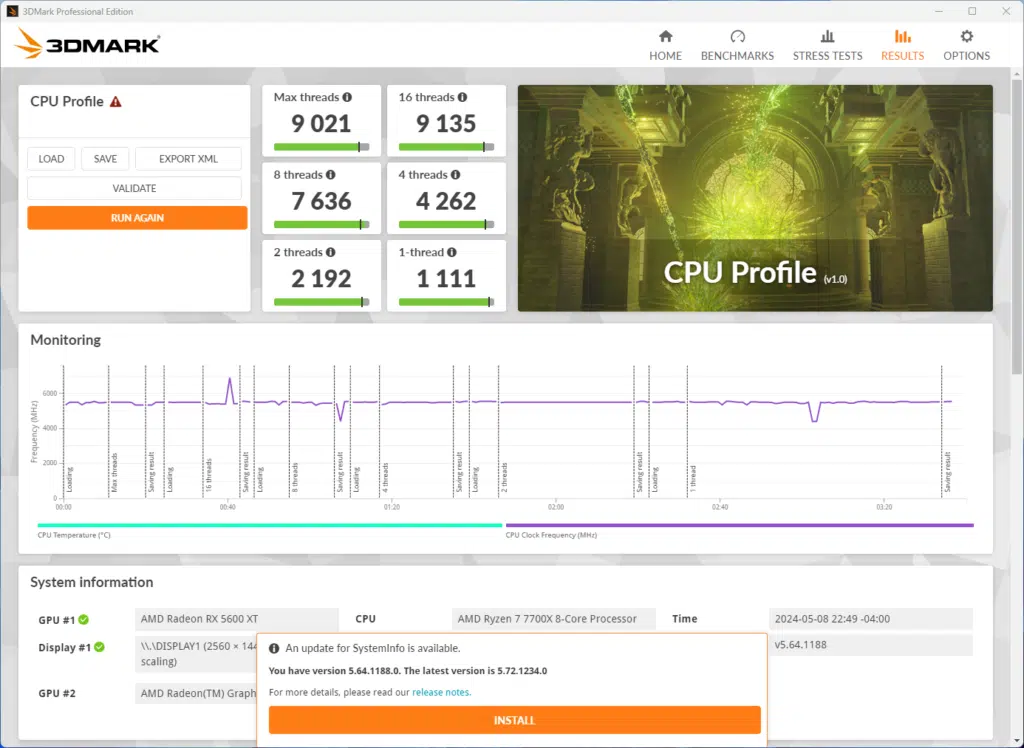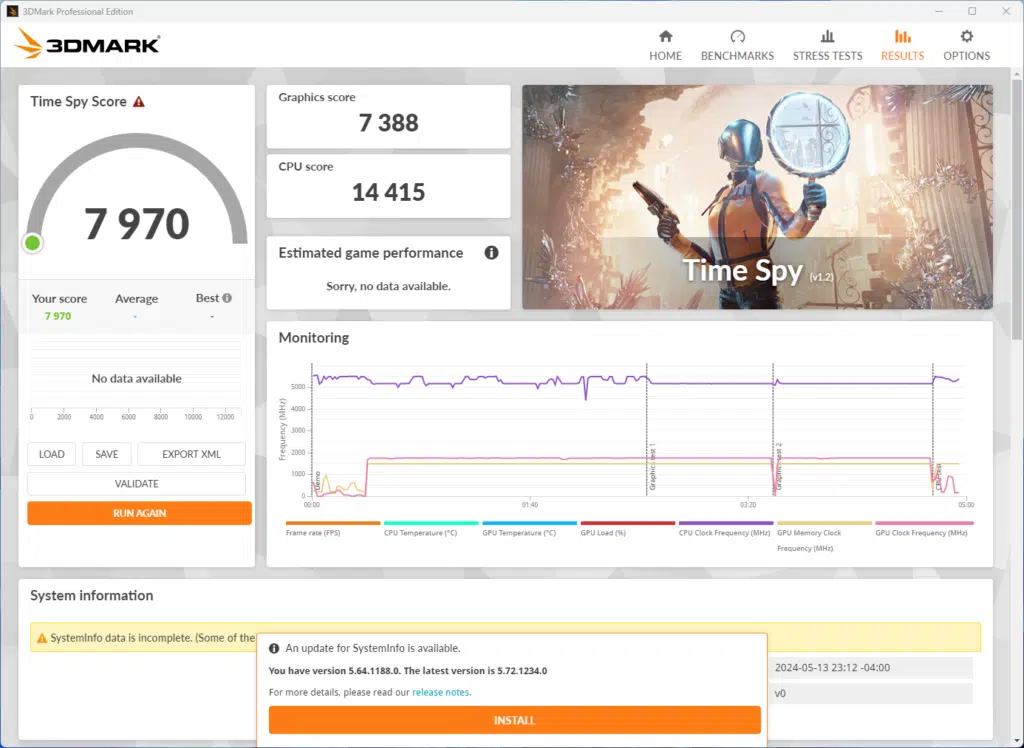
Introduction
Today we have the MSI X670E GAMING PLUS WIFI on our test bench, which is a relatively recent offering from MSI for the X670E line of motherboards. It has a new white gaming aesthetic on the heatsinks and covers, giving it a unique look. With this being an X670E motherboard, it slots in near the top of MSI’s current AMD offerings. Currently, this motherboard is selling for $229 on NewEgg, putting it solidly in the middle of the price range for an X670E motherboard. Similar to our recent AMD motherboard reviews, we will be using our AMD Ryzen 7 7700X, which we reviewed shortly after it came out, by using the 7700X we hope to give a better idea of what a budget-friendly build will be performance-wise and value-wise.
For those unaware, the X670E chipset in this motherboard is currently the top-of-the-line chipset offered by AMD. Natively the chipset gives the user PCIe 5.0 for an M.2 slot, as well as the primary PCIe slot, with this motherboard using 20 of the maximum 24 PCIe 5.0 slots offered by the X670E platform. As is the case with other current X670E motherboards, the primary M.2 slot is able to be used in conjunction with the PCIe 5.0 slot.
Packaging and Contents

Since the MSI X670E GAMING PLUS WIFI is in the middle/low end of the X670E motherboard offerings, the extras are lacking as expected. You will find three (3) M.2 locker screws, a single M3 screw, two (2) SATA cables, the WiFi antenna, a quick installation guide and regulatory notice, and a sheet of stickers, everything you need to get started.
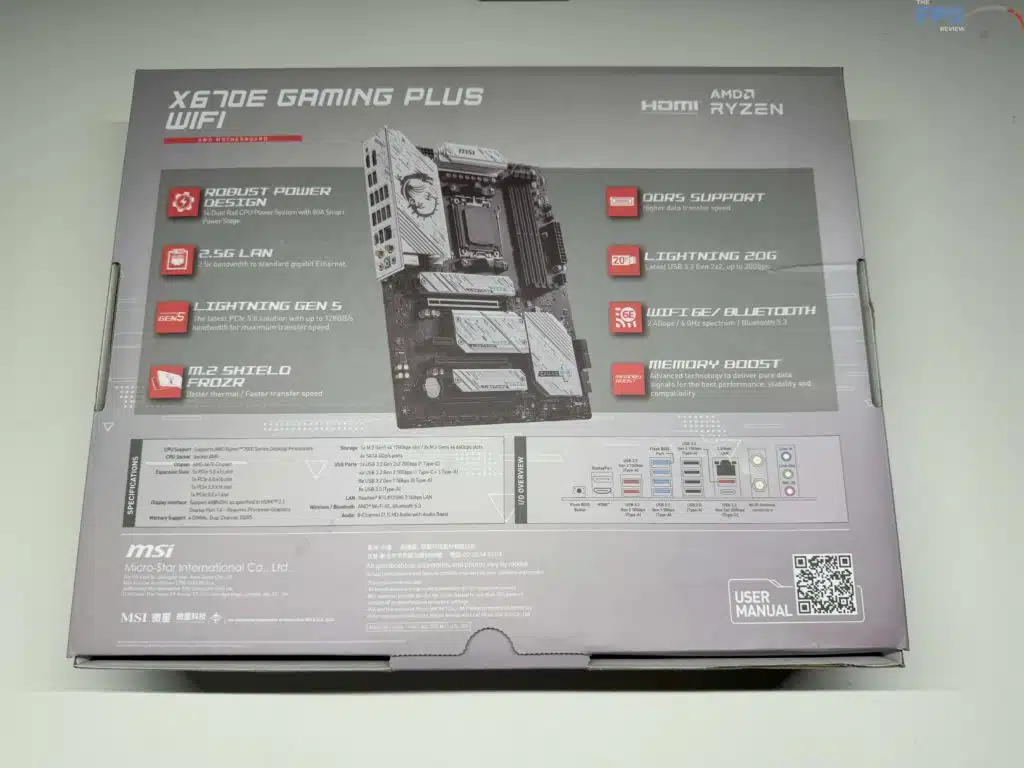
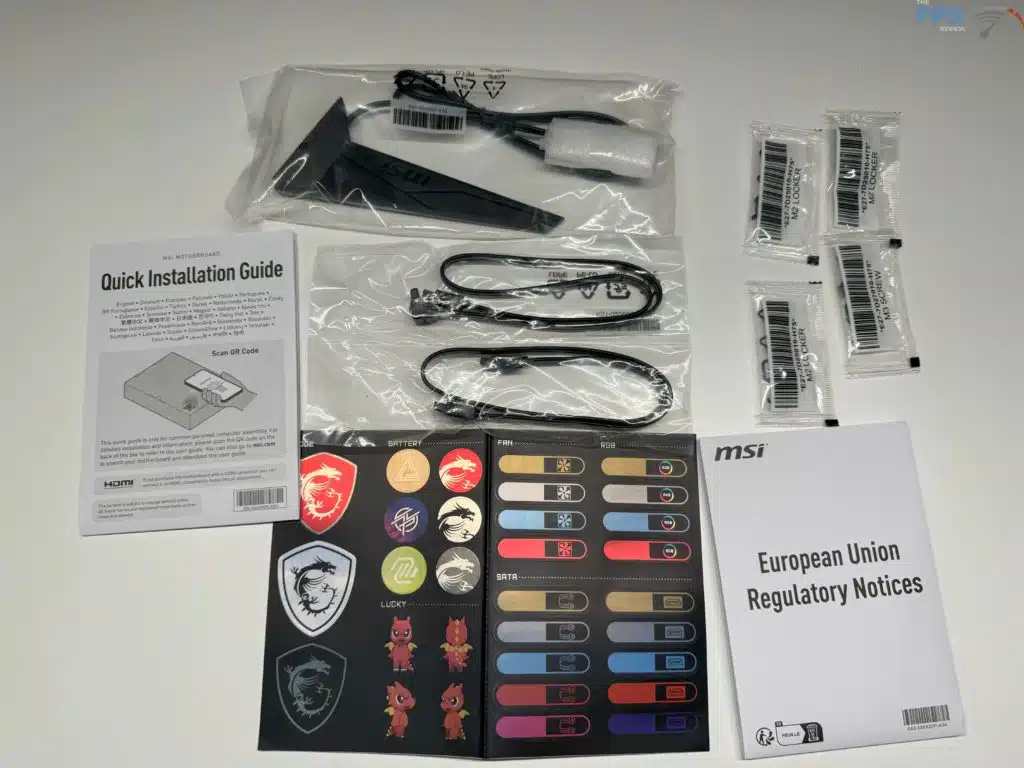
MSI X670E GAMING PLUS WIFI PCB & Features
The first thing you will notice with the MSI X670E GAMING PLUS WIFI is that there is no lack of cooling provided, from the large heat sync on the MOSFETs and VRM’s to the chipset to each M.2 slot having its own heat sync. With this, we did not run into any temperature limitations during our testing, however, the M.2 coolers have minimal “fins” on them and we could see these becoming a limitation in certain use cases. Beyond that the layout does not deviate from the industry standard, power plugs, ports, and expansion offerings are where you expect, and are nothing special.
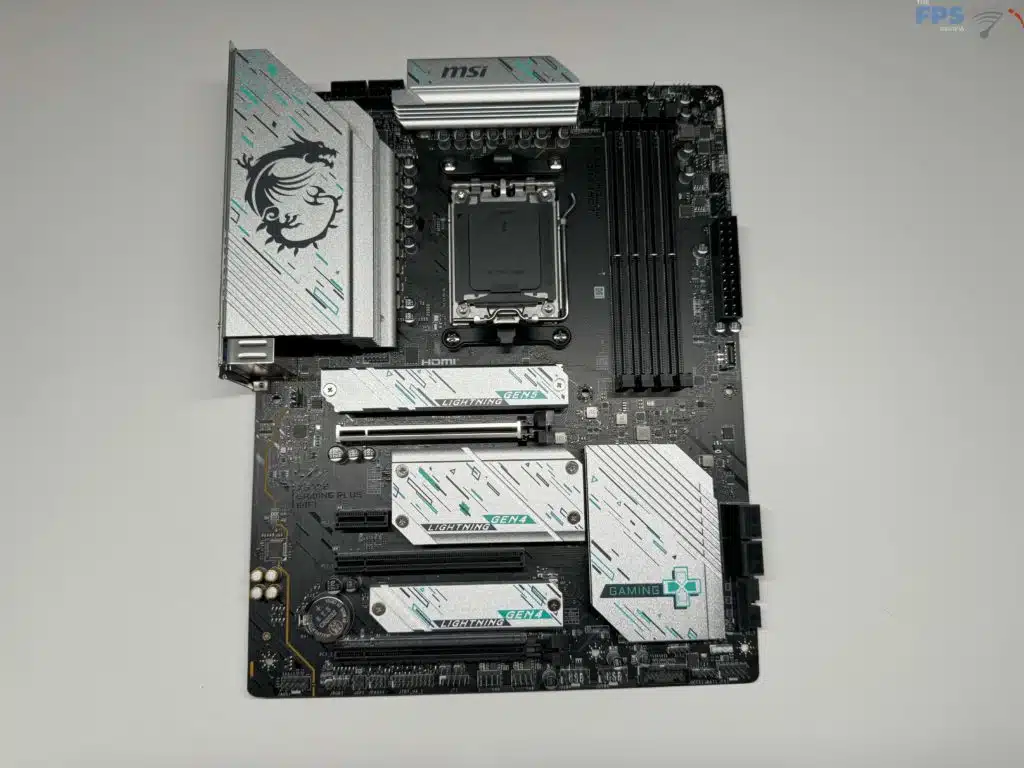
On this motherboard, there is a 14+2+1 VRM design utilizing a Duet Rail Power System (DRPS), including two 8-pin CPU power connectors which is certainly nice to see. While this is not as beefy of a power system as some X670E motherboards have, it is in line with what we would expect from a motherboard in this price range and is very similar to the MSI MAG X670E TOMAHAWK WIFI that we reviewed previously.

The rear I/O of this motherboard is filled with connectivity options. Outside of the standard DisplayPort and HDMI, we have three (3) USB 3.2 Gen 2 10Gbps Type-A ports, four (4) USB 3.2 Gent 1 5Gbps Type-A ports, a single USB 3.2 Gen 2×2 20 Gbps Type-C port, standard audio connectors, a 2.5 Gbps RJ-45 (Powered by a Realtek RTL8125BG chip), wifi connection ports, four (4) USB 2.0 Type-A ports, and finally a BIOS flash button to help with BIOS flashing.
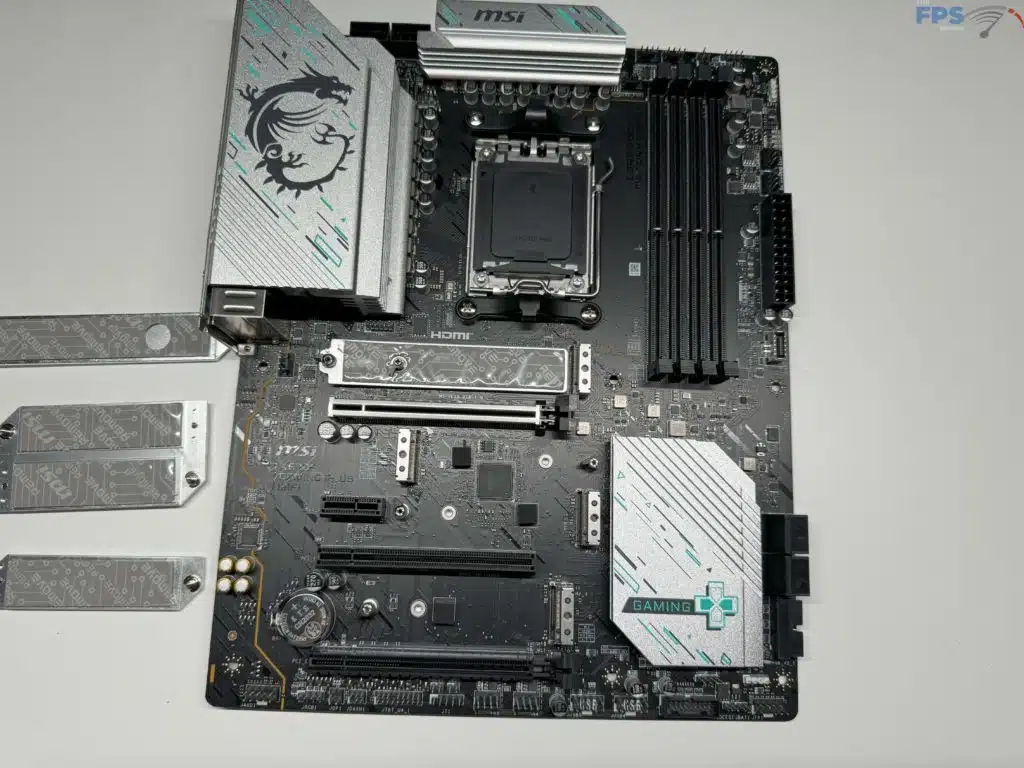
For storage the MSI X670E GAMING PLUS WIFI does nothing very unique, we have a total of four (4) SATA 6 GB/s ports where you expect them, and a total of four (4) M.2 slots. The topmost M.2 slot, M2_1, is the only Gen5 M.2 slot on the motherboard and it has its lanes fed directly from the CPU along with the 2nd slot, M2_2, which provides Gen4 speeds. Beyond this, the bottom two slots, M2_3 and M2_4, are Gen4 slots that are fed from the X670E chipset. All of the M.2 slots can fit at least a 2280 form factor drive, with the Gen 5 slot able to fit up to a 22110-sized drive.
Each slot also has a heat sync provided by MSI, though it is important to note that first these will require a screwdriver to remove, and second that if your drive is provided with cooling it will more than likely be a better cooling option than that provided with the motherboard. One thing we do want to highlight is both the M2_3 and M2_4 slots were a little difficult for us to use the attached M2 “locker” standoffs with due to the proximity to the chipset cooler.

When looking at the PCIe expansion options on this motherboard there are a total of four (4) PCIe slots. The topmost slot supports PCIe 5.0 with full x16 lanes provided by the CPU and is also reinforced with a metal frame to allow for the installation of some of the heavier graphics cards on the market today. As with other motherboards, be conscious about the backplate on your graphics card if you have any plans to install an M.2 Gen 5 drive with its own cooler, you might have some issues with clearance.
Beyond this, the remaining slots are all provided with lanes from the X670E chipset, with the middle two being PCIe 3.0×1 speed, and the bottom-most being PCIe 4.0×4 speed. Unlike some other motherboards we have reviewed, there is no accessible M.2 socket for the WiFi / Bluetooth module.
This motherboard has a few options for USB expansion, namely, there are two (2) USB 2.0 Headers (Supporting up to four (4) USB ports), two (2) USB 3.2 Gen1 headers (Supporting up to four (4) USB ports), and one (1) USB C Gen2x2 header.
For fans, this motherboard will have you pretty well covered. All of the provided fan headers are 4-pin PWM connectors, with one (1) being dedicated to the GPU, one (1) dedicated to a pump, and an additional six (6) connectors for additional fans. Both the Pump and CPU fan are rated for a maximum of 3A / 36W power draw, while the remaining six (6) fans are limited to 2A / 24W per connector.
For those who indulge in RGB lighting in your case, this motherboard does not leave you hanging. While there are no LEDs on the motherboard itself, you will have two (2) JRGB connectors for 5050 RGB LED strips, or fans, along with an additional two (2) Addressable RGB (JARGB) connectors allowing for a maximum of 240 LEDs per connection at a total of 3A. As always, the LEDs can be controlled either in the BIOS or within Windows with MSI’s software.
For memory on this motherboard it is important to remember to only purchase non-ECC, un-buffered memory, and a maximum total capacity of 192 GB is supported. As with other AMD chipset motherboards, the XMP and EXPO memory modules are supported. With this, the motherboard will support memory speeds up to and above DDR5 7800+ Audio is provided by a Realtek ALC897 audio Codec allowing for 7.1 channel surround sound and Nahimic Audio.
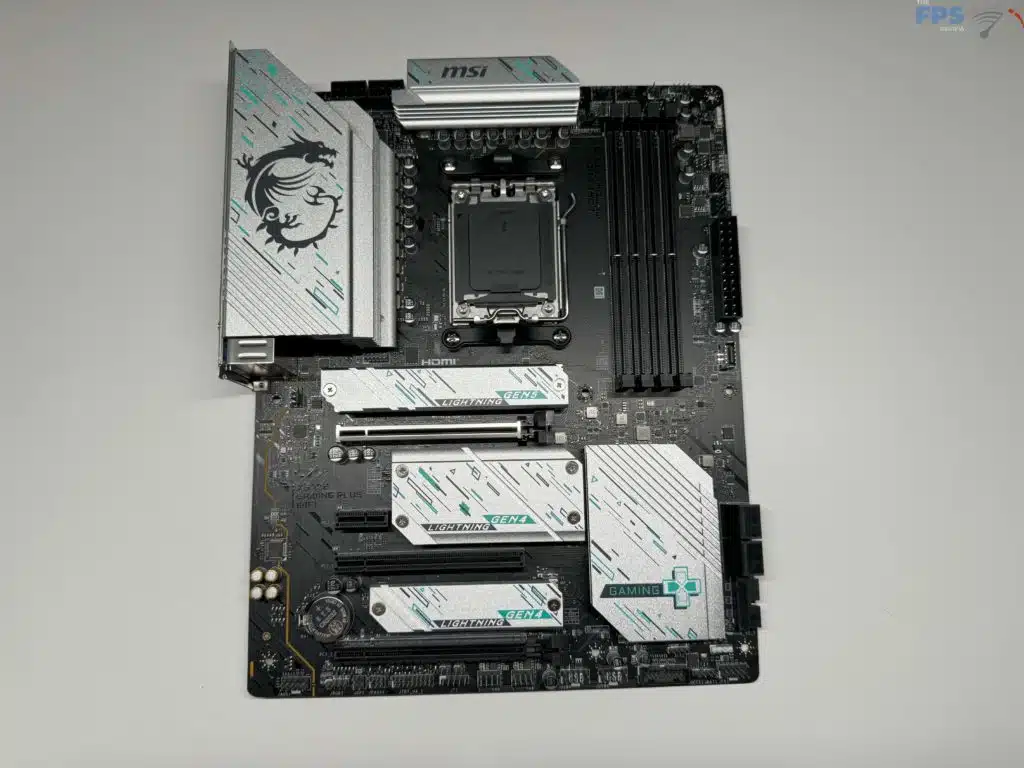
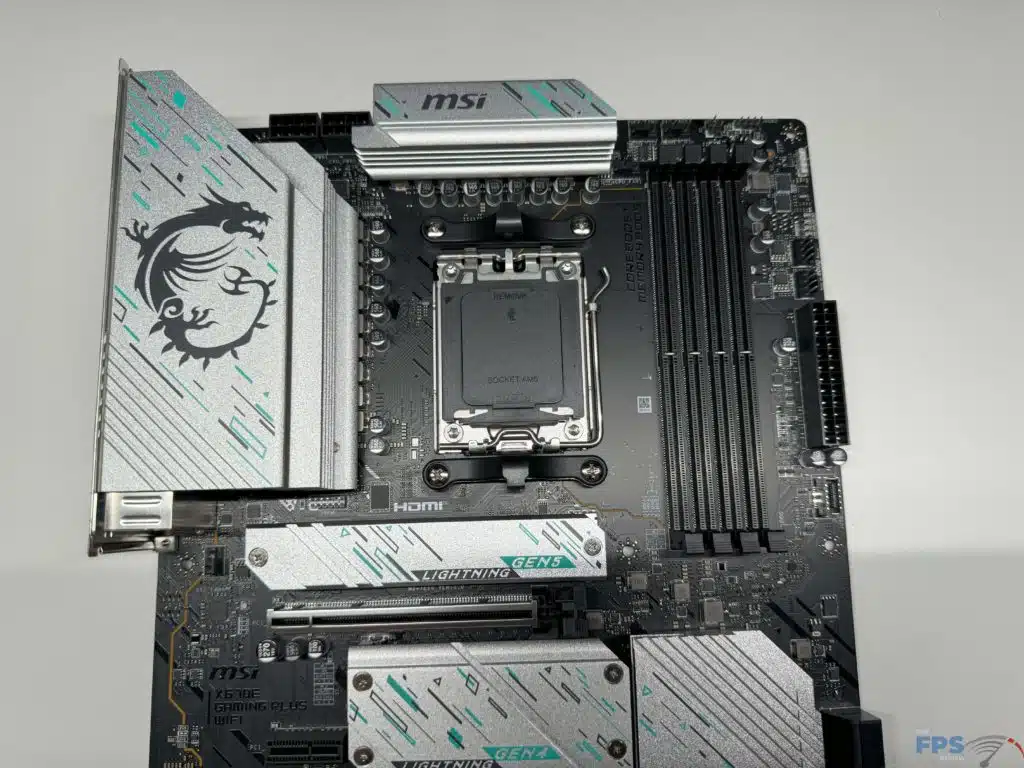

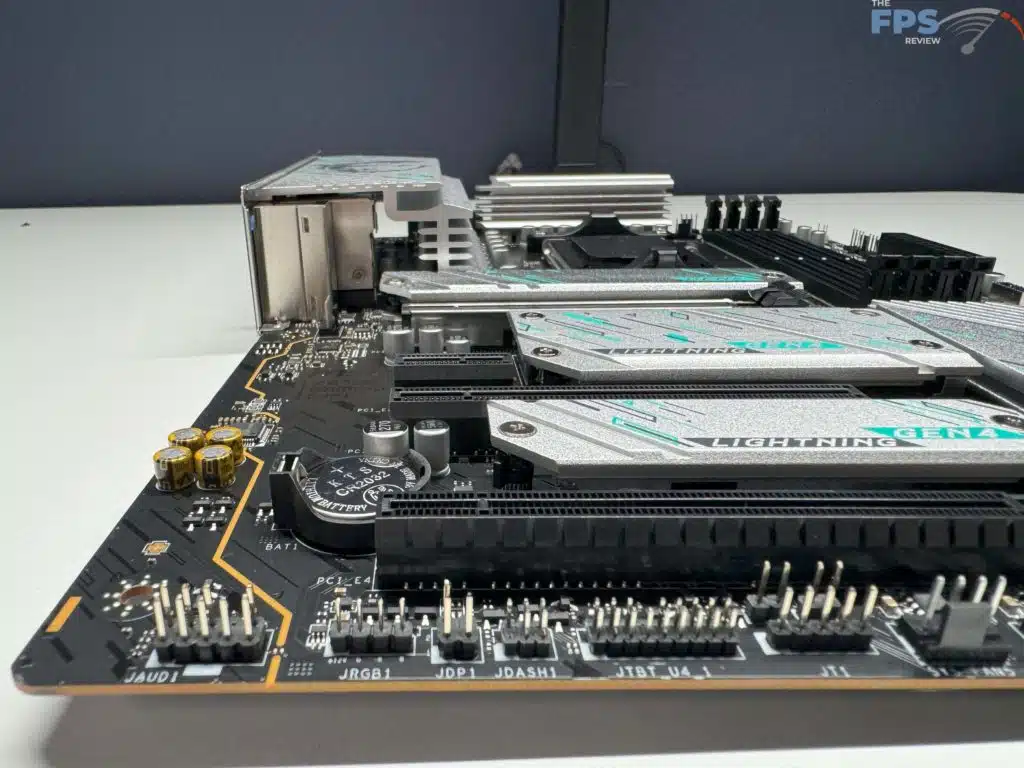
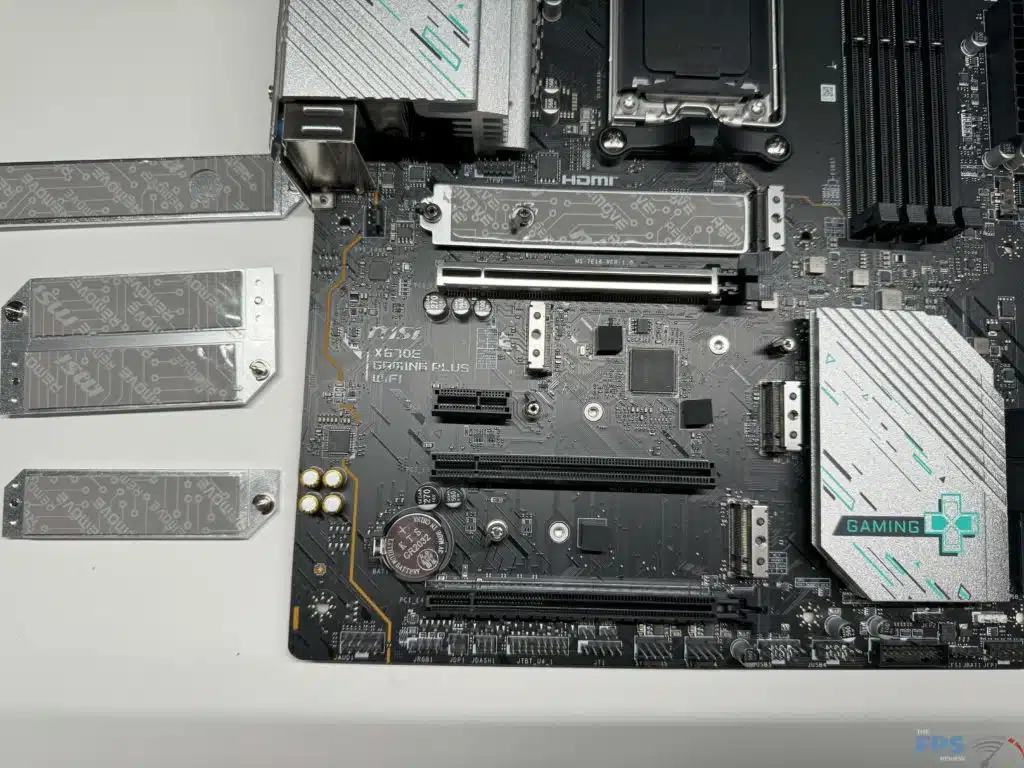
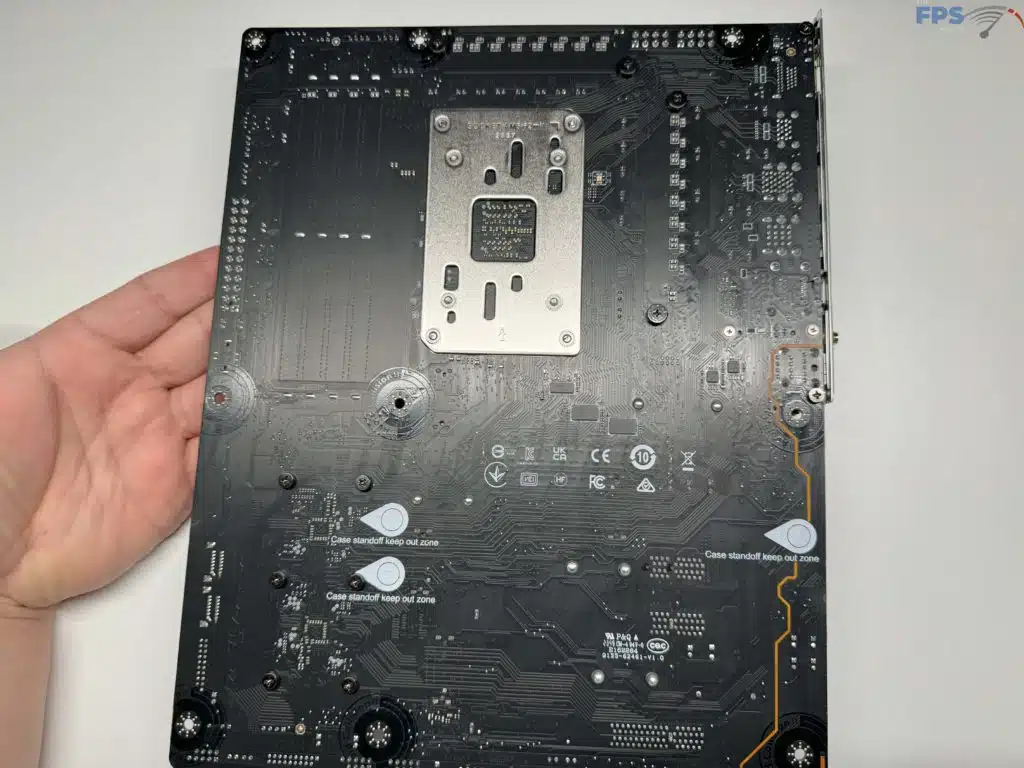
BIOS
The MSI X670E GAMING PLUS WIFI features a 256 Mb American Megatrends Inc. (AMI) UEFI BIOS with a GUI. This BIOS layout is going to feel very familiar to anyone who has used an MSI BIOS in the past, as it uses MSI’s “CLICK BIOS 5” layout. When you first enter the BIOS you will be in the basic screen that gives the user plenty of data right off the bat, such as your CPU and RAM speed, CPU core temperature, and quick adjustments for speeds.
From the basic menu, you can easily adjust fan speeds, LEDs on your system, and even boot orders. Prior to our testing, we made sure to upgrade to the latest stable version, E7E16V14, which was released on April 12, 2024. The upgrade process was painless, just be aware that your first boot may take several minutes depending on the amount of memory you have installed. (Note: We tested with a BIOS that has the AGESA 1.1.0.2b Patch since the time of testing a new version has been released to include the AGESA 1.1.7.0 patch).
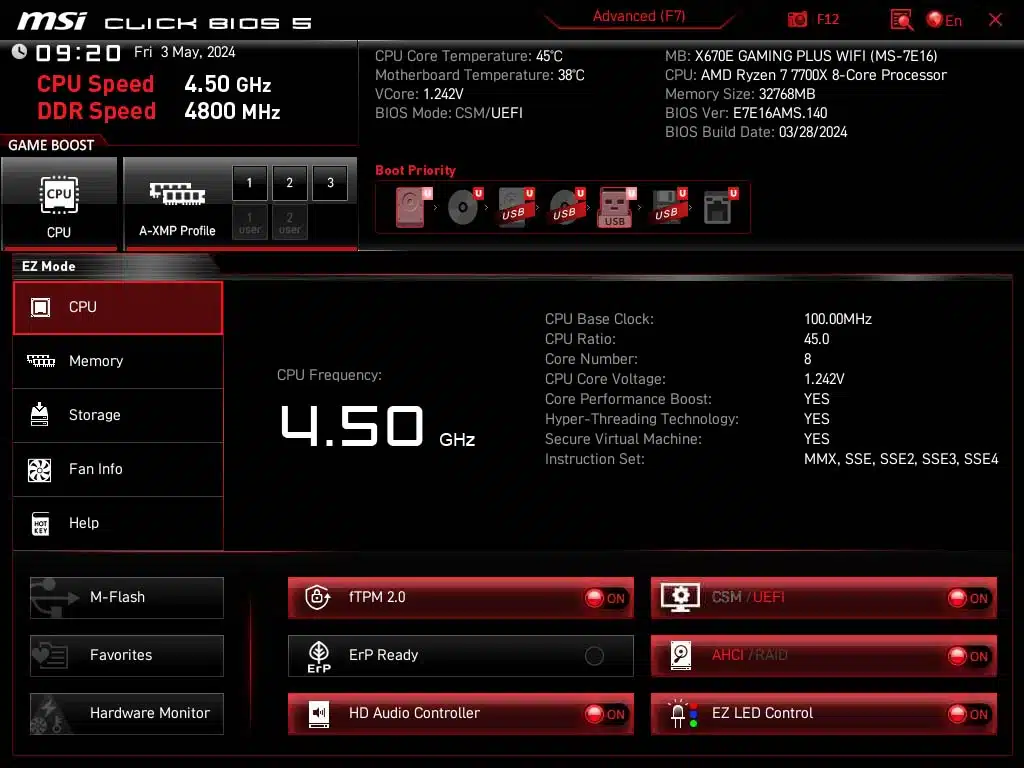
Similar to all of our reviews, we explored the BIOS and had no issues finding any of the settings that we might want to adjust, we will only point out a few of the more prominent features and show a sampling of the options in the gallery at the bottom of this section.
As we mentioned above, the “Basic / Easy” mode for the BIOS layout is very user-friendly and intuitive, however, there are some limitations for those of you who may be looking to deep dive into overclocking with this motherboard. Those of you who are looking to overclock will be happy to know that when you go to the “Advanced” menu (Using the “F7” key) you will be able to modify any setting for your CPU or RAM very easily. Please check out our gallery below to see the major settings that you are able to adjust manually.
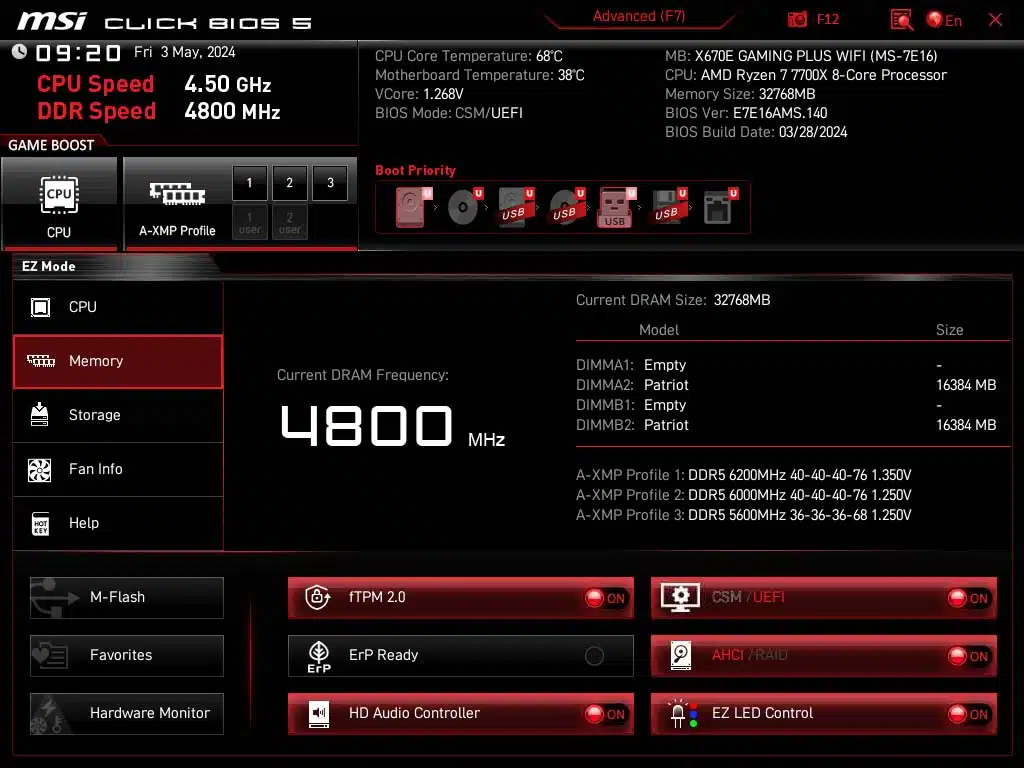
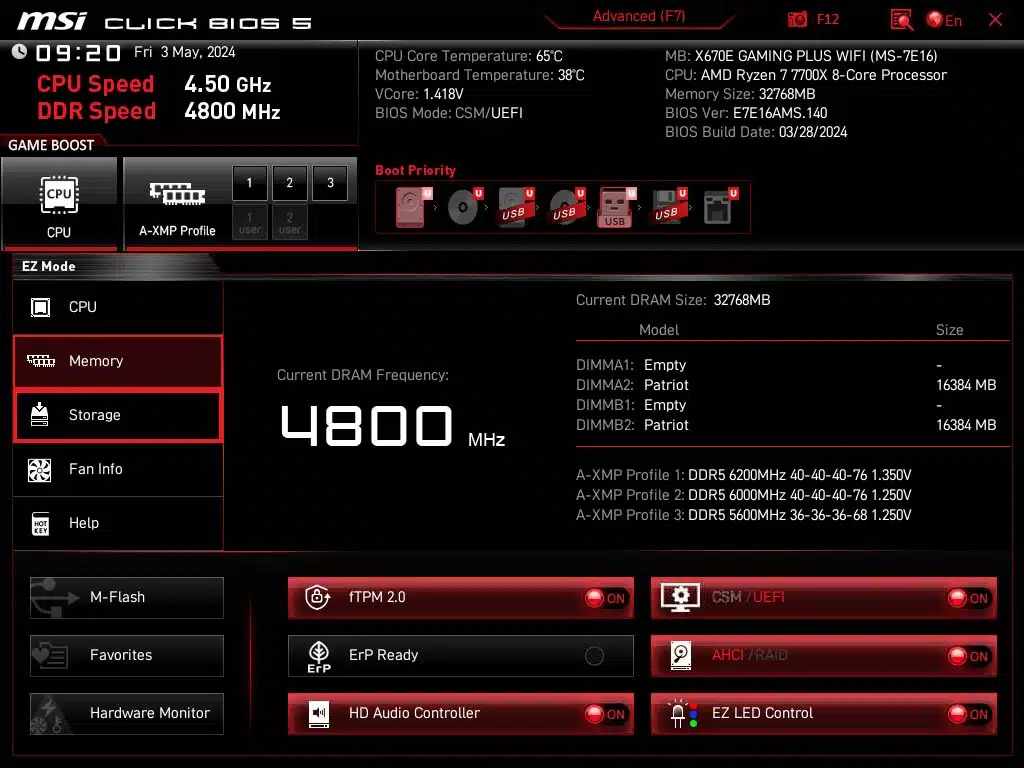
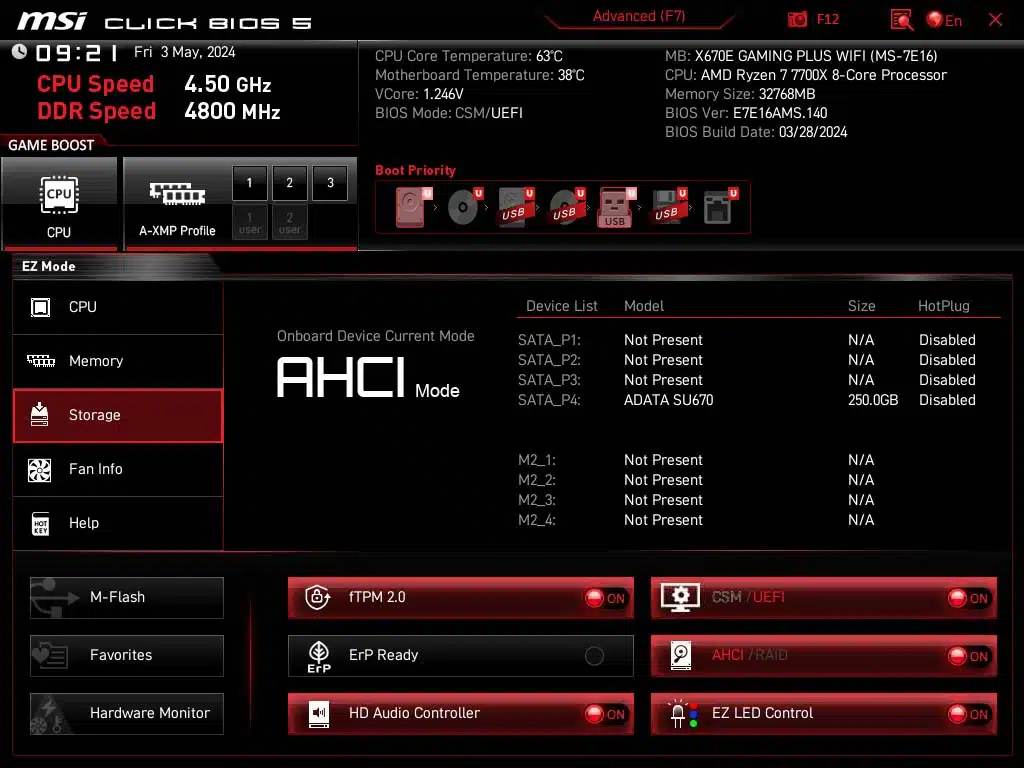
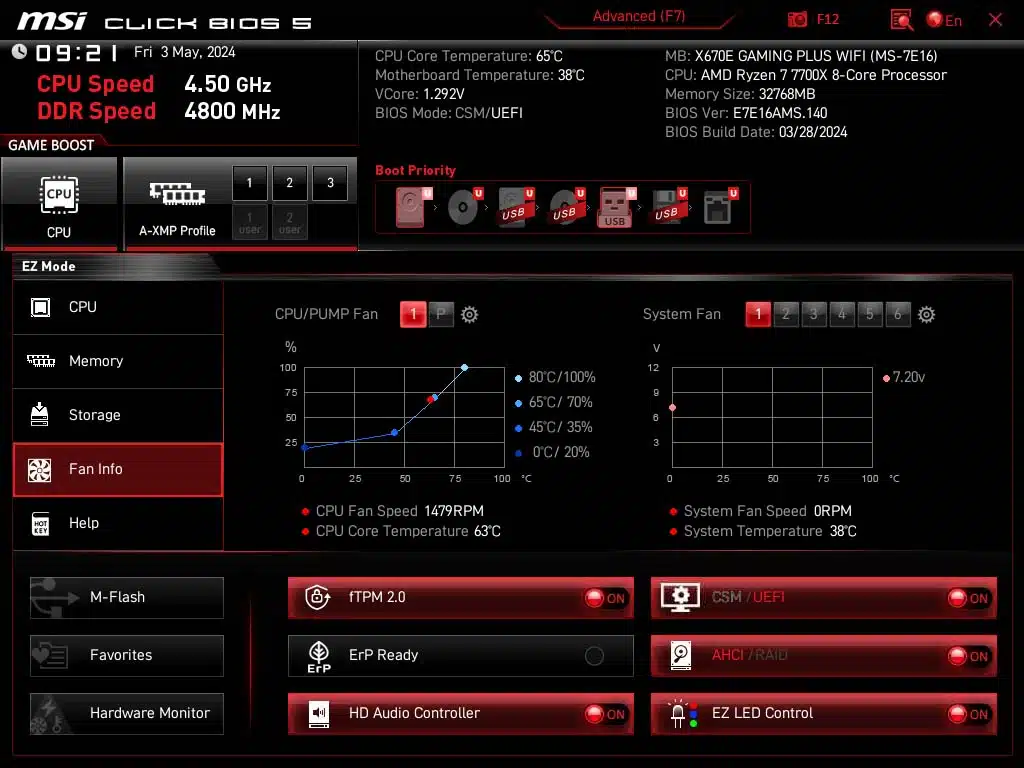

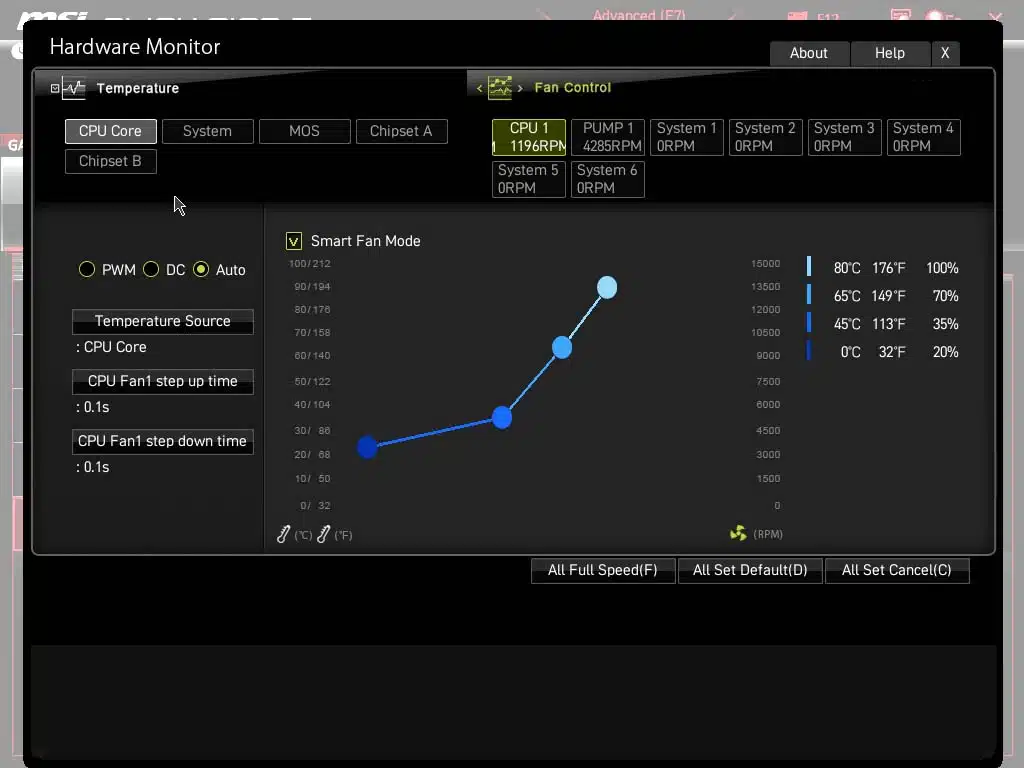

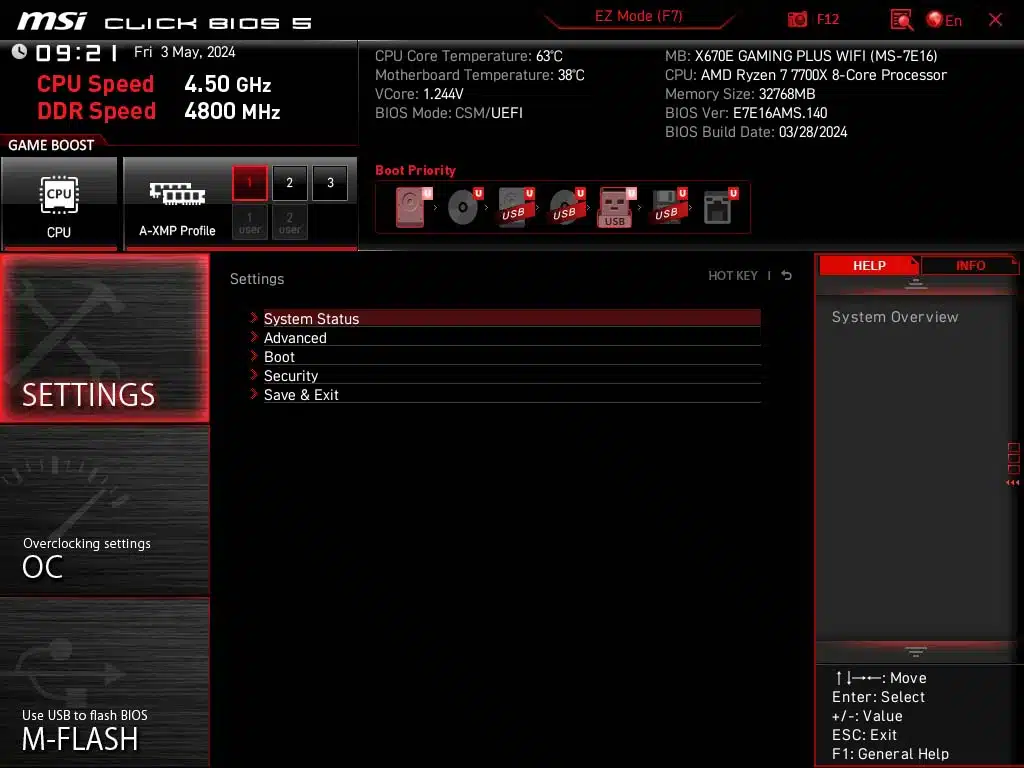

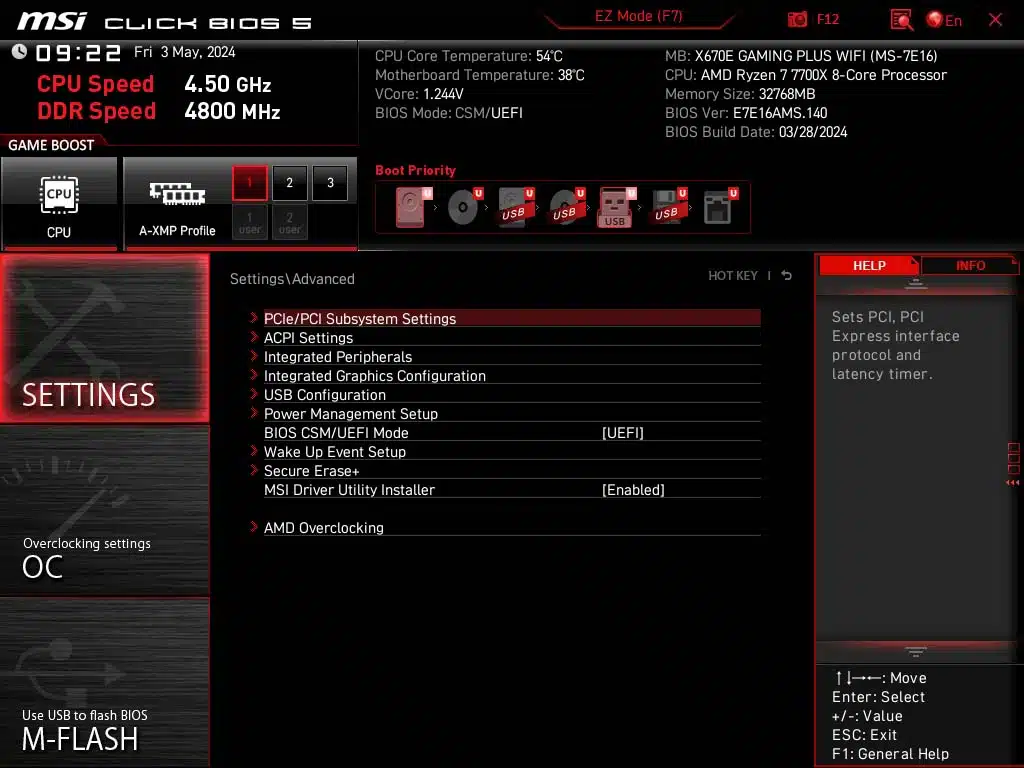
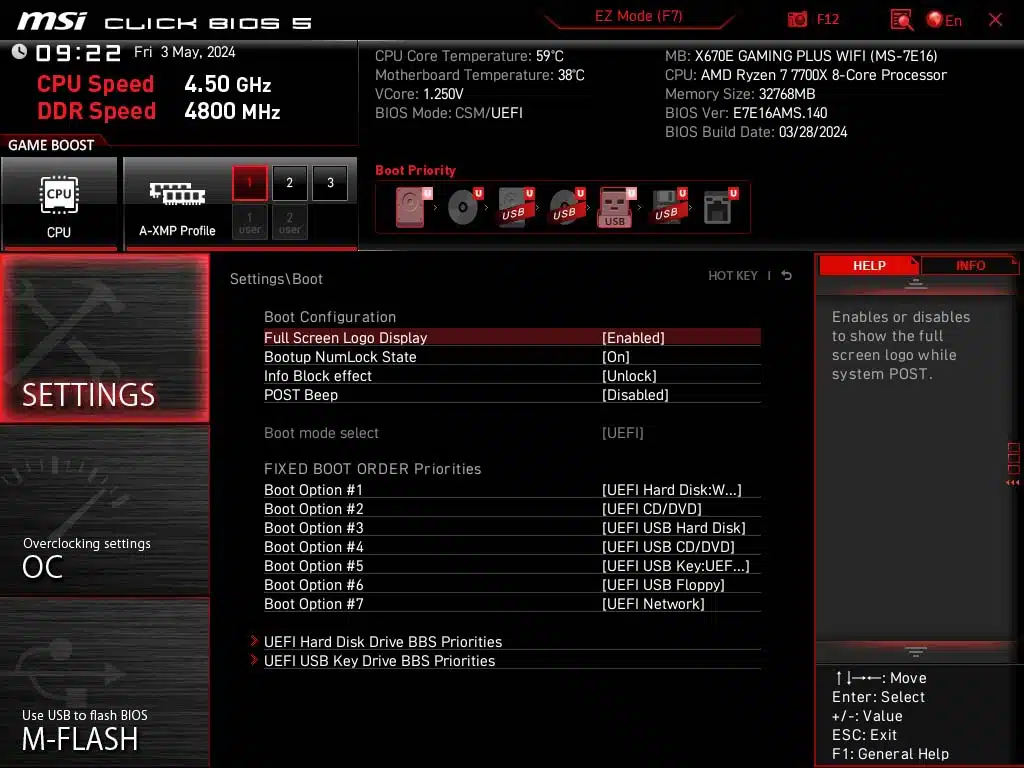
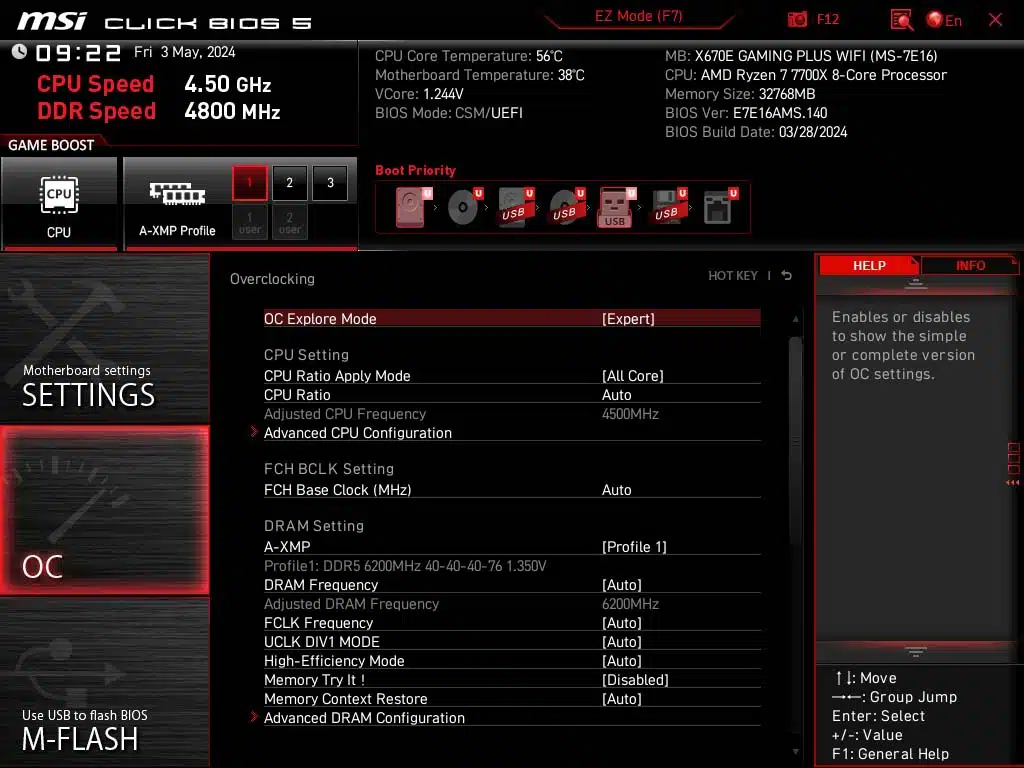

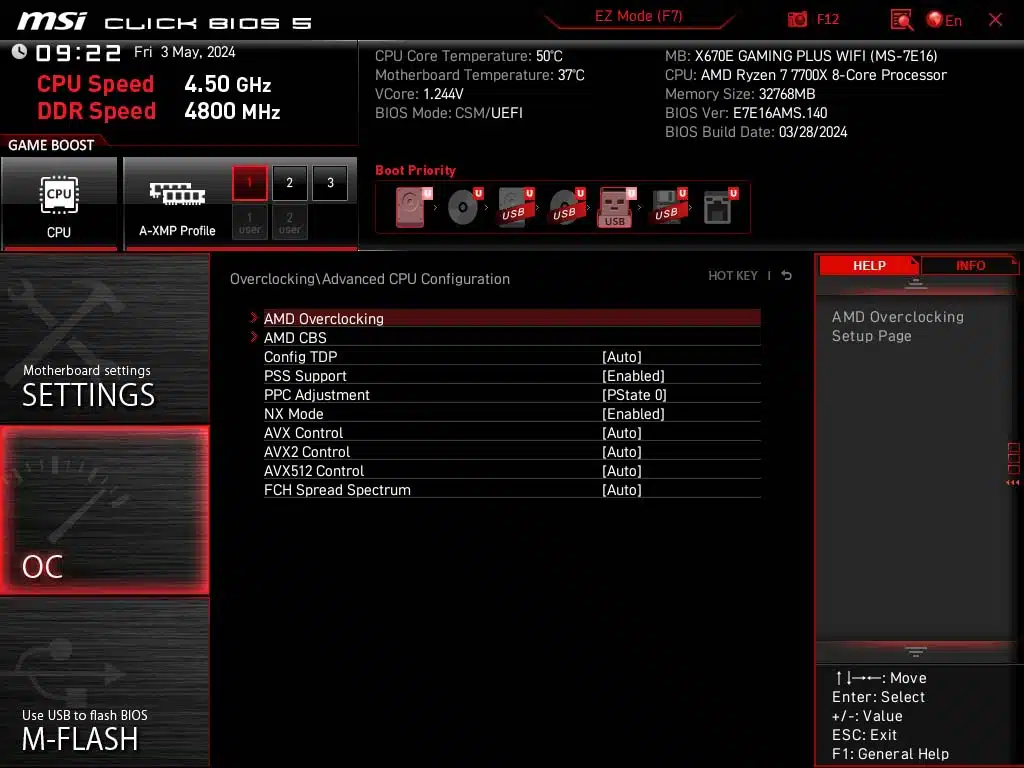
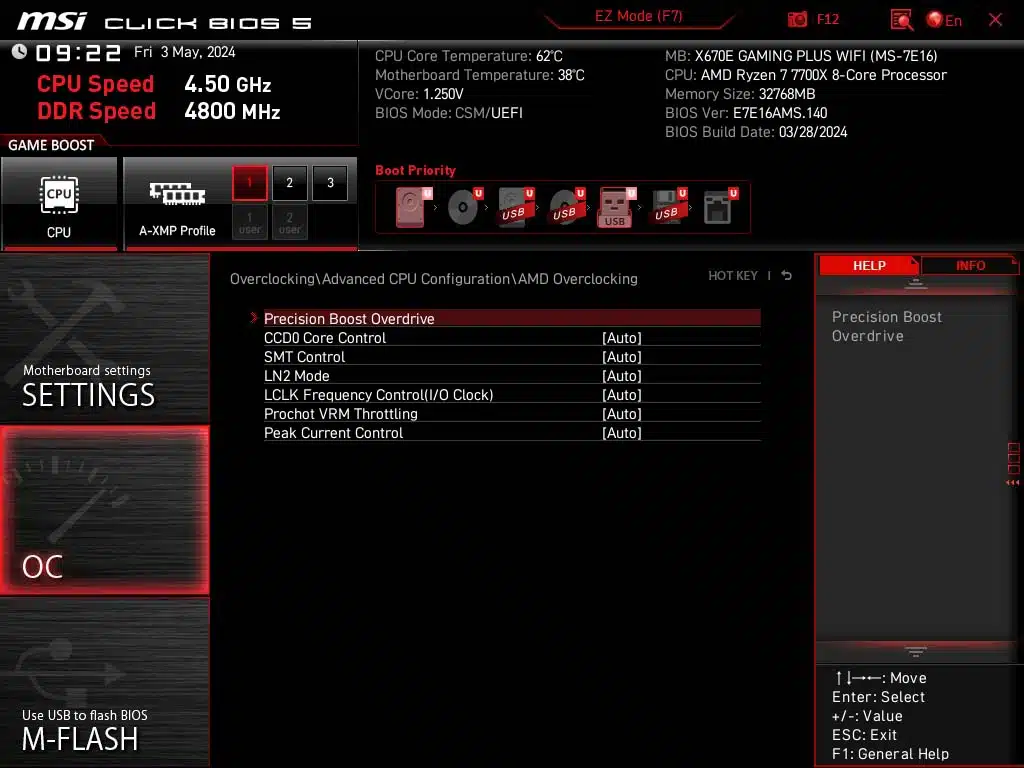
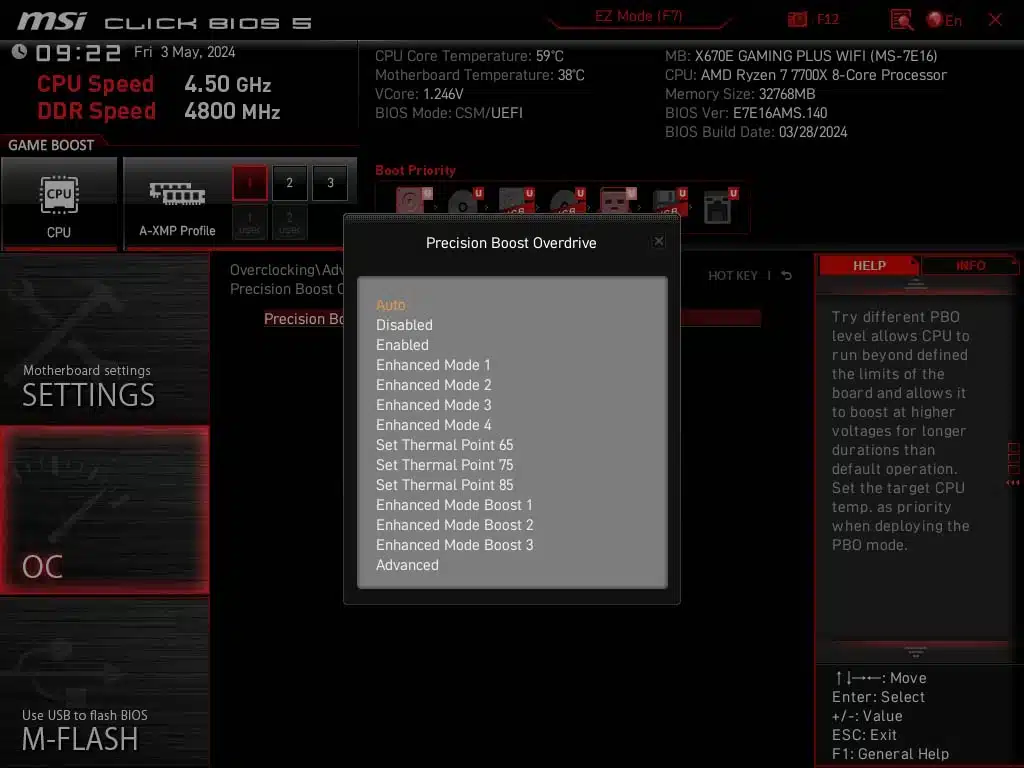
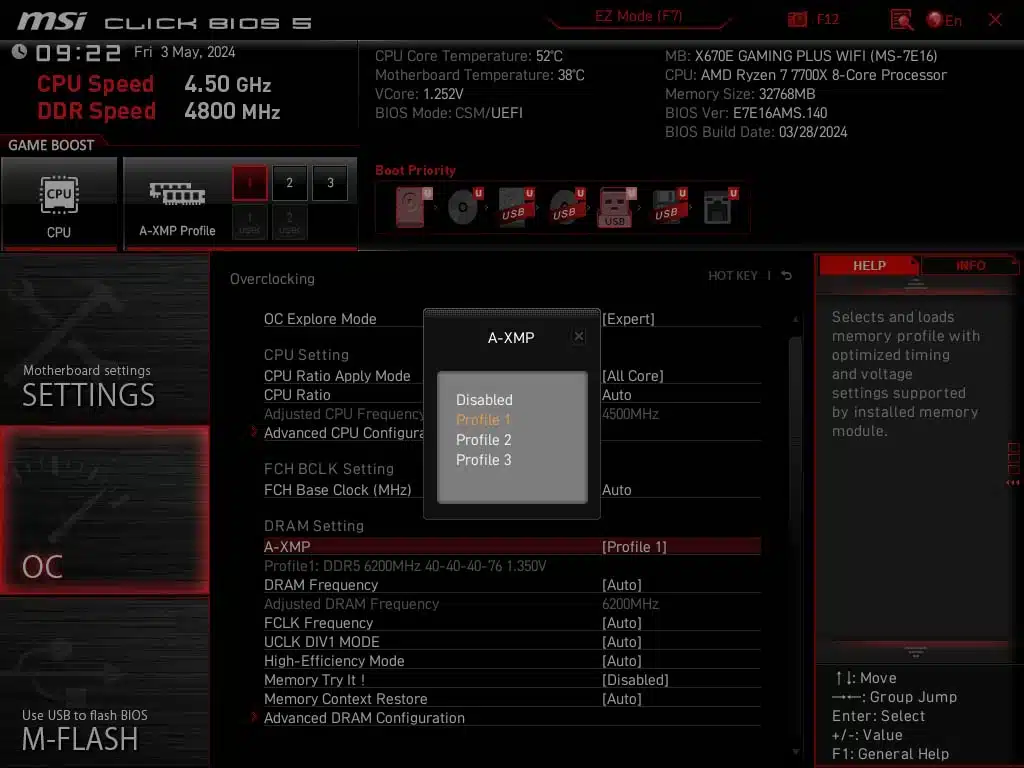
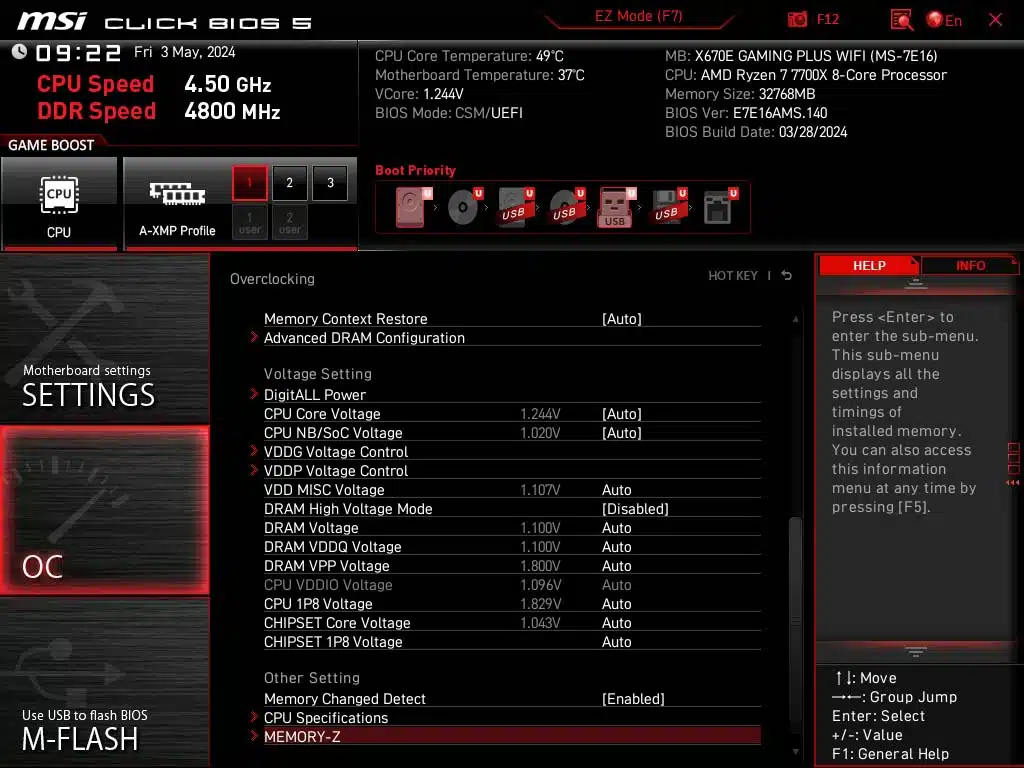
Test Setup
We have the latest BIOS installed, 7E16v14, released on April 12, 2024. All of our testing was performed at the default settings from the BIOS with the exception of the memory, here we set the DRAM to the XMP-1 profile for full speed on our memory.
For the OS setup note that we are on the latest 23H2 Windows 11 update with all incremental Windows updates applied at the time of writing.
As with other motherboards we have recently tested, we are providing the test results below to give an idea of what a user can expect in a pure stock installation. While the option for factory overclocking was available, we only tested the motherboard with a base configuration.
Subsystem Testing
SSD Performance
For this motherboard, we tested the four (4) available slots, and performance is right in line with expected. All of our M.2 slot testing was performed with our PCIe 5.0 test device, the ADATA LEGEND 970 2TB NVME SSE. In our testing with this motherboard, we see speeds right in line with what we have come to expect with this drive. For the M2_1 (PCIe 5.0) slot we were able to achieve 10,070 MB/s read, and 10,192 MB/s write speeds.
The remainder of the M.2 slots available are all Gen4 speeds, however, it is worth noting that M2_2, the only slot other than the Gen5 slot served by the CPU, has a slightly higher read and write speed of 7138 MB/s, and 7009 MB/s respectively, than the other two slots. The two slots served by the chipset were able to achieve a read speed of around 6583 MB/s, and a write speed of about 6476 MB/s.
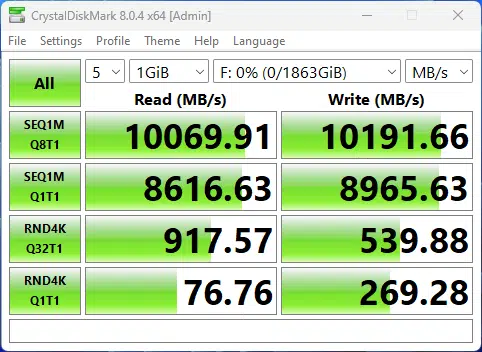
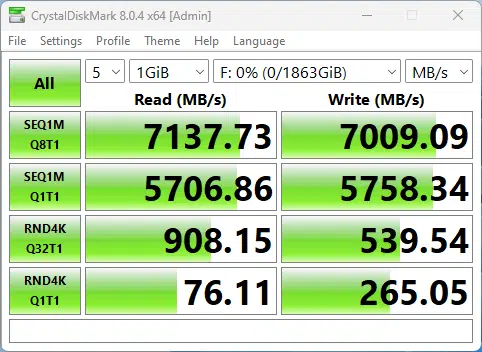
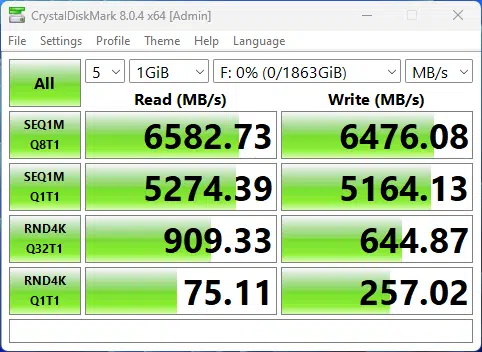
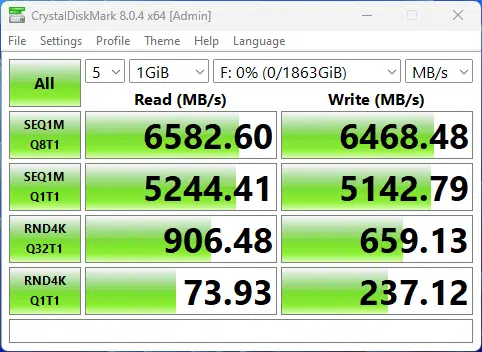
Application Benchmarks
Memory Bandwidth
For our application benchmarks, we are going to start with Aida64, and its memory read and write performance test. At the default settings, with the memory set to 6200MHz, the read performance on this motherboard is 59,160 MB/s of bandwidth, with the write performance coming in at 81,945 MB/s, both of which are right in line with what we are coming to expect from this memory kit. We do want to note that with us moving to the 7700X CPU the write speeds are approximately cut in half due to a single CCD present.
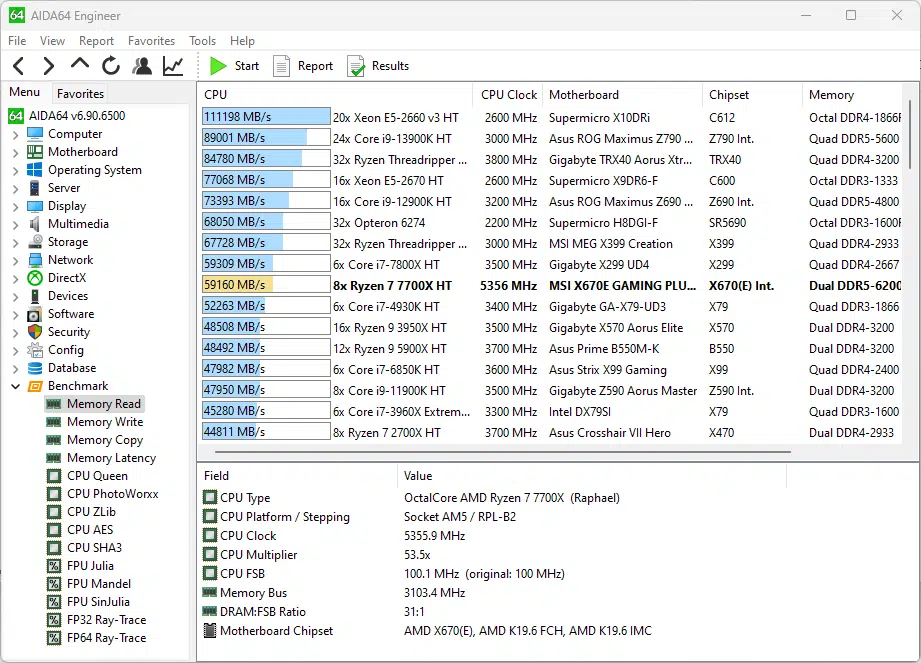
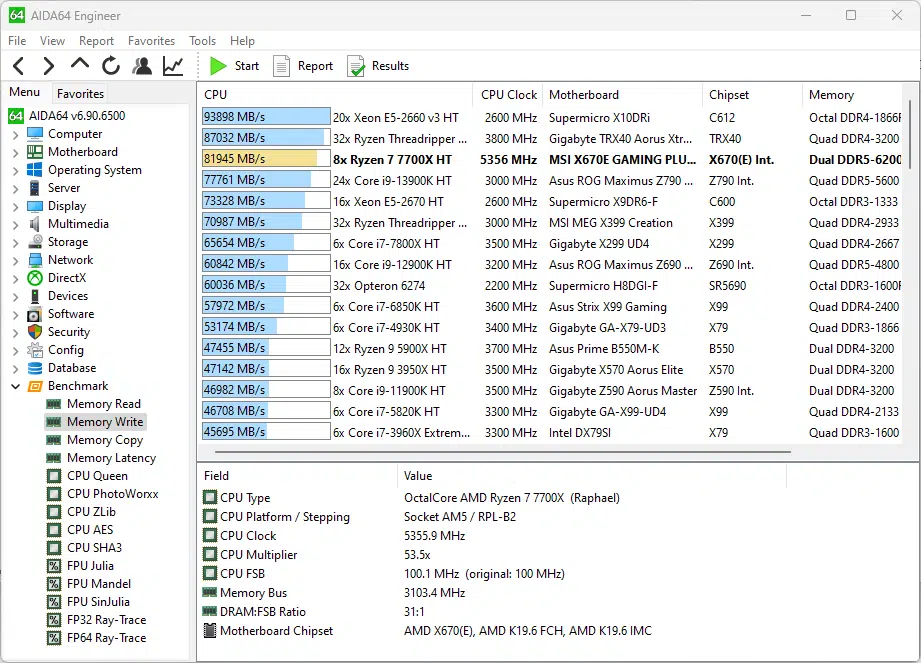
PCMark 10
Cinebench R23
Blender Benchmark
With Blender, we were able to achieve 129.35 samples per minute for the monster test, 89.57 for junkshop, and 65.90 for the classroom tests. We fell slightly short on all Blender tests vs the results when we initially went hands-on with the AMD 7 7700X.
3DMark
V-Ray Benchmark
Conclusion
Today we had the opportunity to get an up-close look at the new MSI X670E GAMING PLUS WIFI from MSI, currently selling for $230 on NewEgg at the time of writing, but be sure to check our pricing widget at the bottom for the latest online pricing. With this price point being at the lower/mid-range for X670E motherboards from all manufacturers, this motherboard compares favorably with its four (4) M.2 slots with a minimum of PCIe 4.0 speeds, along with plenty of fan headers and cooling provided by MSI.
Installation and Use
Installation and setup of this motherboard was very easy, from it being a standard ATX form factor allowing it to fit in the majority of cases, to all fan headers being inaccessible locations, we were able to install this motherboard in short order on our test bed. The only real usability issue we ran into with this motherboard was the proximity of the M2_2 mount point to the chipset cooling. Its proximity presented some challenges for us in securing our ADATA LEGEND 970 2TB NVME SSE drive into the slot. Outside of this, installation of all other components was as easy as you will run into, as was the installation of Windows with updates for all drivers.
Final Points
From today’s testing with the new MSI X670E GAMING PLUS WIFI, we were able to go through our entire testing program without so much as a slowdown from this motherboard. During testing the system was completely stable, and temperatures were very acceptable, but similar to other lower/mid-range X670E motherboards we might air on the side of caution if trying to overclock beyond what AMD’s PBO (Performance Boost Overdrive) provides, due to the cooling on the VRM’s and MOSFET’s.
The final results from testing are right in line with what we have been seeing on our Ryzen 7 7700X CPU, and the Gen5 M.2 slot was able to achieve the speeds we have come to expect. Overall this motherboard met and even exceeded our expectations for a motherboard in the $230 price range.




